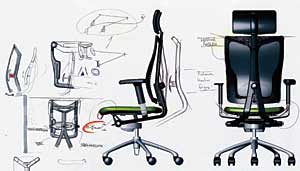Products Made of
Has the loop been closed?
While MBDC will make suggestions on how best to formulate a product so that its constituent parts can be reused in the future, the business policies and actual logistics to make this happen are primarily the responsibility of the manufacturers and product distributors. In light of the testimonies offered by various manufacturers who have worked with MBDC, this appears to be the most challenging aspect of the cradle-to-cradle approach for a host of reasons.
One of the biggest challenges is how to isolate the homogenous material-be it biological or technical-within a larger product or assembly. As a biological nutrient, Pendleton's 100 percent wool can biodegrade pretty much anywhere-and, in essence, close its own loop. In addition, scrap wool fabric can be shredded and processed into basic fibers that can then be spun and used for other items, such as dog beds, coat lining, or even potting soil, or woven into other fabrics, such as blankets. To date, however, the manufacturer is unable to reuse the fabric after it has been subjected to the back-coatings, fire-coatings, and other treatments required in the process of making furniture. Pendleton has been having ongoing discussions with furniture companies to determine if alternative approaches can be explored.
|
Similarly, MechoShade can currently grind undyed fabric intended for use in Ecoveil into its constituent polymer-thermoplastic olefin (TPO)-for reuse in the production of their yarn. However, dyed fabric scraps can only be reused by manufacturers of solid components, such as automobile dashboards. Berman estimates that it will take a couple more years before they will be able to turn it back into their own yarn.
Costs, on a number of levels, can also be a deterrent. According to Gosline, it's still cheaper and easier for the general contractor to take nylon carpet to the dump and pay the current tipping fees rather than spending the time cutting the broadloom into strips and transporting it back to the manufacturing plant to be recycled. And, although Solutia has already pioneered two techniques-dissolution and discoloration-at the laboratory level to convert nylon 6,6 back to basic pellets for reuse, the company still needs to invest more money to test these patented methods at the larger scale of factory production in order to determine if they are economical methods for reclaiming its products after consumers are finished with them.
In the meantime, in an effort to keep carpet out of landfills, Solutia has established a program called Partners for Renewal, in which they identify and work with other entrepreneurs to find alternative outlets for postconsumer carpet waste. One such avenue is Covanta Energy Corporation (www.covantaenergy.com), which converts solid waste to energy for many municipalities across the country. According to Gosline, "Carpet has more BTUs than coal, without dangerous mercury. It's a clean source of energy."
About one and a half years ago, Steelcase launched its Environmental Partnership Program to help its customers figure out what to do with a Steelcase product once they have no more use for it. Although the service is based at the company's headquarters in Grand Rapids, Michigan, they rely on a national network of recyclers, resellers, and nonprofit agencies to avoid sending furniture to a landfill. "Customers call daily and we help them resell their products to another business, donate them to charity, or channel them into refurbishing or recycling streams-all at the local level," says Allan Smith, director of communications and environmental strategy for Steelcase.










